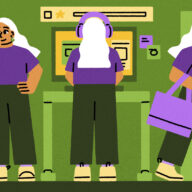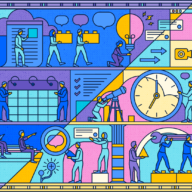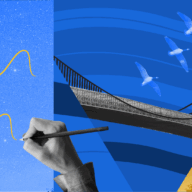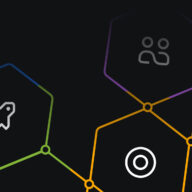Fascinating productivity routines we can learn from nature

Everyone knows the ol’ bird and the bees adage, but we’re not talking about that form of productivity. Nature has always had systems in place, many of which we take for granted: From the Golden ratio, a fascinatingly predictable pattern that is repeatedly found in the structures of plants and sea creatures, to ocean tide schedules that can be tracked down to the minute every day.
All of these behaviors and patterns are natural phenomena that rely on efficiency and sheer productivity. In fact, humans can stand to learn a thing or two from nature… well, maybe except the whole “eating your young” thing.
Jellyfish And Self Care
Taking a cue from one of the most energy efficient animals in the world is never a bad idea. Besides being responsible for literally stirring the world’s oceans, jellyfish propel themselves forward using a suction method that has scientists and engineers star-, er, jelly struck.
To move forward, jellyfish must contract and then relax in order for a second wave of motion to occur. Without the crucial step of relaxing in between, there would be no movement. This minor break in between is also what makes them one of the most productive creatures on the planet!

You’ve heard that relaxing and giving your brain a break is something you should be doing, but how exactly can we learn that from a jellyfish? Well, your brain is one powerful muscle, a muscle that is constantly making decisions (35,000 on average each day!) and constantly stimulated by its environment. Without taking productive breaks you’re at a higher risk of burnout, anxiety, and generally output at a decreased level of productivity.
Productive breaks like taking a walk or cleaning up your desk space not only clear your mindspace, they also increase your capacity to get more done in the immediate future. And take note: jellyfish don’t skimp on their breaks; it’s a vital part of their process. Why not try scheduling break times in your calendar to make sure you relax just as efficiently?
Take it from the humble jellyfish—there’s no moving forward without a little relaxation.
Banter Like The Bees
What says “Zubb Zubb”? A bee flying backwards.
Cheesy joke, not so cheesy science! Bees can indeed fly backwards as well as “speak” to one another using pheromones and dance. That’s right, via a “waggle dance” a bee will convey to her fellow worker bees where the nearest food source is relative to the sun and how far of a journey it will be. Other members of the hive will even convey a new location via dance for when it’s time for the hive to move homes.
Planning ahead and communicating is paramount for honeybees and busy bees alike. For example, have a remote team meeting coming up? Make sure it’s not a few employees in a room with a couple remote employees dialed in via video. Effective communication means doing what’s best for your hive: for example, at Trello the rule is if one person is dialing in via video then EVERYONE is dialing in via video.
Not just meetings, but overall team morale is something bees have down pat. The only time bees are out by themselves is when they’re searching for information and looking to pollinate. Make sure your team behaves similarly. Deep work and research are perfectly appropriate solo ventures, but for big initiatives? Communicate on (at least) a weekly basis on important updates to ensure your team isn’t succumbing to the “silo effect” of keeping information private instead of keeping everyone in the loop.
Whether you’re a remote team across time zones or a co-located team sitting around the table, learn the “waggle dance” your crew understands. While literally dancing with your team could serve to be an interesting meeting, maintaining basic and efficient communication about upcoming tasks is a simple key to everyone’s productivity.
Monkey Business Management
Vervet monkeys are native to South Africa and known for their alarm communication structure. Unlike bees, these monkeys will loudly vocalize when trying to convey a message, especially a message saying, “Look out, there’s a predator!” Vervet monkeys will scream a warning based on what type of predator is posing a threat. Snake? “Get in the tree.” Eagle? “Get on the ground.”
What scientists find most interesting, however, is how vervets can distinguish between adult speech and juvenile speech. If a juvenile issues a warning, adults will wait until another adult verifies the juvenile’s message. Sound judgmental? It’s not; it’s because juveniles haven’t gotten the lingo and oftentimes confuse the warning signals—which could mean life-ending mistakes for the troop, such as retreating to the ground when a snake is present instead of escaping into the trees.
Instead of vilifying the juvenile, the troop understands that mistakes are a part of the learning process and use other adults as a feedback system. The productivity of any team relies on having a system in place to empower new teammates, as well as anticipating common mistakes.
So next time someone flubs on a presentation or decides to respond with “reply all,” be sure to kick that adult feedback system into gear. Mistakes happen, don’t let them kill your productivity.
Plants And Productivity
Perhaps one of the easiest productivity hacks, plants have been found to increase workplace happiness and even increase memory retention. According to the American Psychological Association, the “most toxic space” for humans is one without plants or photographs. Scientists note how the minimalist and ‘lean’ office culture is doing more harm than good. Plopping a desk plant near your space could increase your productivity by 15%, not only that but improving your air quality correlates to better overall focus.

Another cue from plants is how natural light helps you thrive! Like plants, employees working solely under artificial light in the workplace have been found to suffer from lower quality sleep and had poorer outcomes in measures of their physical health. Time to grab your potted pals and surround yourself in sunlight.
Off To The Jungle?
When you’re stuck in front of a screen for almost 50 hours a week, it’s hard to see how your outdoor counterparts are faring. You don’t need to be outside to take advantage of the tricks they have up their sleeves (or tentacles). Turns out being efficient and working in a team is what most critters are striving for. Whether it’s small tweaks to your office decor or shifts in mindset when it comes to teamwork, your next productivity breakthrough might just be roaming out there in the wild.
Next: The ‘Coffee Shop Effect’: Why Changing Your Location Boosts Your Productivity










































